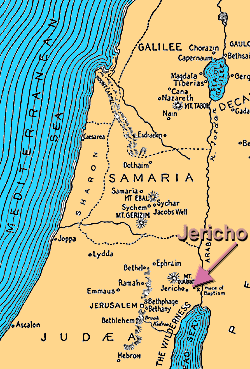Has the biblical city and story of Jericho been verified?
Excavations at the ancient mound of Jericho in the southern Jordan valley of Palestine have yielded extraordinary finds that verify the veracity of Biblical accounts. The only surviving written history of Jericho is that recorded in the Bible. Archaeology has demonstrated that the Biblical record is a precise eyewitness account of events that transpired there many thousands of years ago.
The most famous story about Jericho, of course, is that of the walls falling, as detailed in Joshua 6. Another less known, but nonetheless important, account is that of Eglon, king of Moab, building a palace there and extracting tribute from the Israelites for 18 years (Judges 3:12-30). Space does not allow a detailed discussion of the evidence, so I will briefly list the main finds and their correlation with the Bible.
At the time of the Israelite Conquest, Jericho was heavily fortified, as the Bible implies (Joshua 2:5,15).
Piles of mud bricks from the collapsed city wall were found at the base of the tell, verifying that “the wall fell beneath itself” (Hebrew, watippol hahomah tahteyha, Joshua 6:20).
An earthen embankment around the city required the fighters to go “up into the city” (Joshua 6:20).
Houses were built against a portion of the city wall that did not collapse, verifying that Rahab's house was built against the city wall (Hebrew, betah be qir hahomah, Joshua 2:15), and that her house was spared (Joshua 2:14-21; 6:22-23).
A layer of ash 3-foot thick with burned timbers and debris demonstrates that the Israelites “burned the whole city and everything in it” (Joshua 6:24).
-
The destruction occurred at the end of the 15th century BC, precisely the time of the Conquest of Canaan according to the internal chronology of the Bible (I Kings 6:1; Judges 11:26; I Chronicles 6:33-37). Many large jars full of charred grain were found in the destroyed buildings. This is a very rare find since, because of its value, grain was normally plundered from a vanquished city. The large amount of grain at Jericho indicates:
The harvest had just been taken in (Joshua 2:6; 3:15).
The siege was short (seven days, Joshua 6:15).
The Israelites did not plunder the city (Joshua 6:18).
Also see: THE WALLS OF JERICHO - Is the Bible accurate concerning the destruction of the walls? - Answer
There was evidence of earthquake activity, possibly the agency God used to dam up the Jordan (Joshua 3:16) and bring the walls down.
[For further details, see Bryant G. Wood, “Did the Israelites Conquer Jericho?,” Biblical Archaeology Review, March-April 1990: 44-58; and The Walls of Jericho, Bible and Spade, Spring 1999: 35-42.]
Following the destruction of Jericho the site lay abandoned for a number of decades. Then, an isolated palace-like structure was constructed. It was excavated by British archaeologist John Garstang in the 1930s. He called it the “Middle Building,” since it was sandwiched between Iron Age structures above and the destroyed 15th century B.C. city below. The archaeological finds in this stratum match the Biblical description exactly.
The Middle Building dates to the second half of the 14th century BC, the time of Eglon's oppression according to Biblical chronology (ca. 1400 BC less the remainder of the life of Joshua, Judges 2:6-9; the eight-year oppression by Cushan-Rishathaim, Judges 3:8; and 40 years of peace under Othniel, Judges 3:11).
The plan of the building is similar to other palaces of the period and fits the description given in the Bible.
The Middle Building was an isolated structure, as the Bible implies. There was no evidence for a town at Jericho at this time.
The resident was well-to-do, as seen by a large quantity of imported Cypriot and other decorated pottery.
The resident was involved in administrative activities, as evidenced by a cuneiform tablet, a rare find in Palestine.
The building was occupied for only a short period of time and then abandoned.
[For further details, see: John Garstang, “The Story of Jericho: Further Light on the Biblical Narrative,” American Journal of Semitic Languages and Literature 58 (1941), pp. 368-72; Baruch Halpern, “The Assassination of Eglon: The First Locked-Room Murder Mystery,” Bible Review, (December 1988), pp. 2-41.]
More information
- ABOUT JERICHO (Christian Answers WebBible Encylopedia article)
- Is the Bible accurate concerning the destruction of the walls of Jericho? Answer
- FOR CHILDREN: Scientists discover proof - The walls of Jericho DID fall (KidExplorers.com)
- Archaeology and the Bible—Providing archaeological evidence in support of the Bible. Our team of experts answers your questions about the Bible and archaeology. To Menu
Author: Bryant G. Wood, Ph.D. of Associates for Biblical Research. Provided by AIIA Institute.
Copyright © 2001, AIIA Institute, All Rights Reserved—except as noted on attached “Usage and Copyright” page that grants ChristianAnswers.Net users generous rights for putting this page to work in their homes, personal witnessing, churches and schools.





